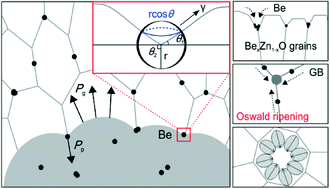Pinning effect on the band gap modulation of crystalline BexZn1−xO alloy films grown on Al2O3(0001)
Abstract
We have investigated the influence of Be concentration on the microstructure of BexZn1−xO ternary films (from x = 0 to 0.77), grown on Al2O3(0001) substrates using radio-frequency co-sputtering. With increasing Be concentration, the (0002) X-ray diffraction peak shows a systematic shift from 33.86° to 39.39°, and optical spectroscopy shows a blue-shift of the band gap from 3.24 to beyond 4.62 eV towards the deep UV regime, indicating that Be atoms are incorporated into the host ZnO lattice. During the band-gap modulation, structural fluctuations (e.g. phase separation and compositional fluctuation of Be) in the ternary films were observed along with a significant change in the mean grain size. X-ray photoelectron spectroscopy indicates higher concentrations of metallic Be states found in the film with the smaller grain size. Correlation between these two observations indicates that Be segregates to near grain boundaries. A model structure is proposed through simulation, where an increase in grain growth driving force dominates over the Be particle pinning effect. This leads to further coalescence of grains, reactivation of grain growth, and the uniform distribution of Be composition in the BexZn1−xO alloy films.


 Please wait while we load your content...
Please wait while we load your content...